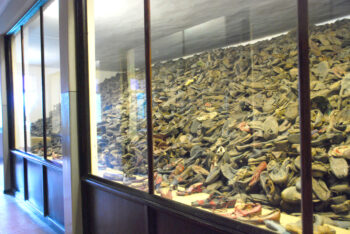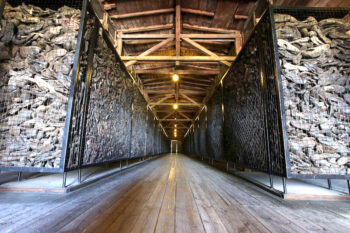Shoes of Deportees

 Shoe exhibit at the Majdanek Museum today. (Some of it was destroyed in a 2010 fire.)
Shoe exhibit at the Majdanek Museum today. (Some of it was destroyed in a 2010 fire.)Both the Auschwitz Museum and the Majdanek Museum have an exhibit on display showing what are said to be the shoes of former camp inmates. (See the illustrations.)
The shoes of Majdanek used to be piled up in a barracks, where the Soviets photographed them in the summer of 1944. They presented these photographs as evidence for mass murder committed at Majdanek. The shoes in the Auschwitz show case consist merely of one layer put on an inclined plane to give the false impression that this is a large pile of shoes. These, too, are presented as evidence for mass murder at Auschwitz, although these shoes’ origin is completely unknown and undocumented.
A pile of shoes, in and of itself, proves nothing but the fact that someone has put them there. If it were otherwise, any collection of old clothes and shoes for charities would prove mass murder of the former owners.
As numerous wartime documents show, the SS operated a huge clothing and shoe manufacturing and recycling operation at Majdanek. Among other things, worn-out or damaged shoes and clothes from Germany’s armed forces, as well as clothing and shoes of inmates admitted to various camps, were all sent to Majdanek for further processing. Right opposite of where the Soviets found the shoe storage at Majdanek is the camp’s shoemaker workshop (Schumacher-Werkstätte), and it is even labelled as such. The fact was later recognized by orthodox historians, although they still insist that many if not most of the former owners of the clothes and shoes sent to Majdanek were murdered.
Most notably, the Majdanek Museum displays to this day at their infamous shoe-storage building a sign at the entrance stating that these shoes belonged “to victims of ‘Operation Reinhardt.’” According to the orthodox Holocaust narrative, Aktion Reinhardt was the code name for the wholesale slaughter of European Jews by National-Socialist Germany. (See the entry on Aktion Reinhardt.)
It goes without saying that it is not possible to determine the fate of an item’s former owner by staring at the item in devotion. This is possible only by assessing anecdotal, documental, material and forensic evidence.
(For more information, see Rudolf 2023, pp. 18-21.)

You need to be a registered user, logged into your account, and your comment must comply with our Acceptable Use Policy, for your comment to get published. (Click here to log in or register.)